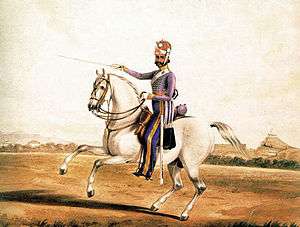16th Light Cavalry
The 16th Light Cavalry is a regiment of the Armoured Corps, a primary combat arm of the Indian Army. Prior to India gaining independence from the British in 1947, it was a regular cavalry regiment of the British Indian Army. It was formed in 1776 and is the oldest armoured regiment raised in India.[1] The 16th Light Cavalry saw service in a number of conflicts ranging from the Second Anglo-Mysore War in 1781 to World War II. It has a number of battle honours including "Punjab 1965" earned during the Indo-Pakistani War of 1965.
| 16th Light Cavalry | |
|---|---|
| Active | 1776 – present |
| Country | India |
| Allegiance | |
| Branch | |
| Type | Armoured |
| Size | Regiment |
| Engagements | Second Anglo-Mysore War Third Anglo-Mysore War Fourth Anglo-Mysore War Third Anglo-Burmese War Third Afghan War World War I World War II |
| Battle honours | Sholinghur-1781 Carnatic-1784 Mysore-1792 Seringapatam-1799 Burma-1885-1887 Afghanistan-1919 Meiktila-1945 Capture of Meiktila-1945 Defence of Meiktila-1945 Pegu-1945 Sittang-1945 Rangoon Road-1945 Burma-1945 Punjab-1965 |

History
Formation
The Regiment was raised prior to 1776 as the 3rd Regiment of Native Cavalry in the service of the Nawab of Arcot. In 1780, while under service with the British East India Company, it formed part of the force that defeated Hyder Ali during the Second Anglo-Mysore War and was awarded battle honours for the Battle of Sholinghur, Battle of Mysore, Battle of Carnatic and the Battle of Seringapatam for service during the Anglo-Mysore Wars. After the Anglo-Mysore Wars the Regiment was next in action during the Third Anglo-Burmese War and were awarded the Battle Honour of Burma 1885-87.[2]
Early 20th Century
During World War I (1914–1918) the regiment remained in India for the defence of the North West Frontier but they did send drafts to other Indian cavalry regiments serving in France and the Middle East. In 1919 the regiment was involved in the brief Third Afghan War, for which they were awarded the battle honour of Afghanistan 1919.[2]
World War II
During World War II the regiment was employed in the defence of India having converted from horses to armour at Quetta in 1941.
In 1945 they were selected to undertake operations in Burma. Within three weeks the Regiment covered a distance of 3,500 miles from Quetta to the banks of Irrawaddy River and was personally complimented by General Slim, the Fourteenth Army commander.[2]
In Burma the regiment were 14th Army troops and were also attached to the 255th Indian Tank Brigade, the brigade formation was;
- 116 Royal Armoured Corps (formed from the Gordon Highlanders) - Sherman tanks.
- 7th Light Cavalry - Stuart
- 16th Light Cavalry - Humber and Daimler armoured cars (B squadron).[3][4]
Lineage
- 1776 – Regiment of Cavalry (Stevenson's), Nawab of Arcot's Army
- 1784 – 3rd Madras Native Cavalry
- 1784 – 1st Madras Native Cavalry
- 1786 – 4th Madras Native Cavalry
- 1788 – 2nd Madras Native Cavalry
- 1819 – 2nd Madras Light Cavalry
- 1886 – 2nd Regiment of Madras Lancers
- 1901 – 2nd Madras Lancers
- 1903 – 27th Light Cavalry
- 1922 – 16th Light Cavalry
- 1947 – Allocated to India at independence and partition,[2] continues in service as 16th Light Cavalry
Battle honours
The battle and theatre honours of the 16th Light Cavalry are:[5]
- Pre-World War I
- World War I and later
- The Second World War
- Meiktila
- Capture of Meiktila
- Defence of Meiktila
- Rangoon Road
- Pegu 1945
- Sittang 1945
- Burma 1942-45.
- Indo Pak Conflict 1965
Notes
- Jackson, Major Donovan (1940). India's Army. London: Low, Marston. pp. 135–142. ISBN 978-81-87226-37-6.
- "16th Light Cavalry". 16cavroa.com. Archived from the original on 2020-03-10.
- Fowler, William (26 February 2009). We Gave Our Today: Burma 1941-1945. Orion. p. 176. ISBN 978-0-297-85761-7.
- Davies, R. Mark. "British & Indian Armoured Units Of the Burma Campaign : A Painting Guide" (PDF). Fire and Fury Games. Retrieved 29 March 2014.
- Singh, Sarbans. Battle Honours of the Indian Army 1757 - 1971. New Delhi: Vision Books. p. 305. ISBN 81-7094-115-6.
References
- Kempton, C. (1996). A Register of Titles of the Units of the H.E.I.C. & Indian Armies 1666–1947. Bristol: British Empire & Commonwealth Museum. ISBN 978-0-9530174-0-9.
- Gaylor, J. (1992). Sons of John Company: The Indian and Pakistan Armies 1903–1991. Stroud: Spellmount Publishers Ltd. ISBN 978-0-946771-98-1.